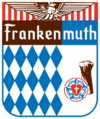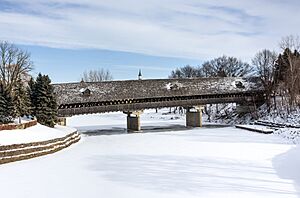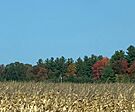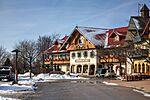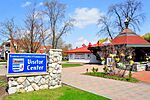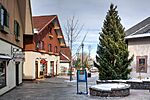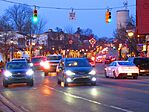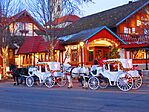Frankenmuth, Michigan facts for kids
Quick facts for kids
Frankenmuth, Michigan
|
||
|---|---|---|
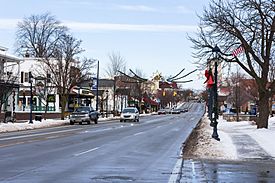
Downtown Frankenmuth along Main Street
|
||
|
||
| Nicknames:
Little Bavaria, Muth, The Muth
|
||

Location within Saginaw County
|
||
| Country | United States | |
| State | Michigan | |
| County | Saginaw | |
| Settled | 1845 | |
| Incorporated | 1904 (village) 1959 (city) |
|
| Government | ||
| • Type | Council–manager | |
| Area | ||
| • Total | 3.17 sq mi (8.20 km2) | |
| • Land | 3.11 sq mi (8.05 km2) | |
| • Water | 0.06 sq mi (0.15 km2) | |
| Elevation | 637 ft (194 m) | |
| Population
(2020)
|
||
| • Total | 4,987 | |
| • Density | 1,604.05/sq mi (619.30/km2) | |
| Time zone | UTC-5 (EST) | |
| • Summer (DST) | UTC-4 (EDT) | |
| ZIP code(s) |
48734
|
|
| Area code(s) | 989 | |
| FIPS code | 26-30200 | |
| GNIS feature ID | 1626303 | |
Frankenmuth (pronounced FRANK-ən-mooth) is a city in Saginaw County, Michigan. It's a state in the United States. In 2020, about 4,987 people lived there. The city is surrounded by Frankenmuth Township.
The city's name has a special meaning. "Franken" comes from the Franconia region in Bavaria, Germany. This is where the first settlers came from. The German word "Mut" means "courage." So, Frankenmuth means "courage of the Franconians." People often call it "Little Bavaria" because of its strong German roots.
Contents
History of Frankenmuth
Early Settlers and Their Mission
Frankenmuth was settled by Lutheran immigrants from Germany in 1845. They left Germany on a ship called the Caroline. After a long journey, they arrived in Michigan in August 1845. They traveled by canals and the Great Lakes to get there.
The main reason for their settlement was religious. The Lutheran group wanted to start a mission to teach Native Americans about their faith. They built a church as one of their first large buildings. However, their mission didn't succeed because many Native Americans were forced to leave the area.
Growth and German Heritage
The settlers chose a hilly area that reminded them of their home in Germany. They wanted Frankenmuth to be a German Lutheran community. They promised to stay loyal to Germany and keep their German language. More Germans continued to arrive until World War II.
Frankenmuth started as part of a larger township. It became a village in 1904. Later, in 1959, it officially became a city. The German culture is still very important in Frankenmuth today. You can see German words on signs and hear the language spoken. The local church, St. Lorenz, even has monthly services in German.
Geography and Location
Frankenmuth covers about 3.04 square miles (7.87 square kilometers). Most of this area is land, with a small part being water. The Cass River flows right through the middle of the town.
Community and People
Population Over Time
Frankenmuth has grown steadily over the years. Here's how the population has changed:
- 1910: 693 people
- 1920: 733 people
- 1930: 925 people
- 1940: 1,100 people
- 1950: 1,208 people
- 1960: 1,728 people
- 1970: 2,834 people
- 1980: 3,753 people
- 1990: 4,408 people
- 2000: 4,838 people
- 2010: 4,944 people
- 2020: 4,987 people
Who Lives in Frankenmuth?
In 2010, there were 4,944 people living in Frankenmuth. Most residents, about 97.4%, were White. About 0.8% were Asian, and 0.5% were African American. About 1.9% of the population was Hispanic or Latino.
Many people in Frankenmuth have German heritage. In 2010, nearly half the population (49.3%) reported having German ancestry. Other common backgrounds included English (12.9%), Polish (8.6%), and Irish (6.3%).
Economy and Tourism
Tourism and farming are the main parts of Frankenmuth's economy. Many festivals and events happen throughout the year to attract visitors. A lot of people in the area also work in agriculture.
In 2022, the Bavarian Inn Lodge announced a huge expansion. They are adding a 140,000 square foot area. This will make their water park the largest indoor park in Michigan. It will also be the fourth largest in the world!
Unique Architecture
Frankenmuth is famous for its special building style. Most buildings, especially in the main shopping areas, look like traditional German timber-framed houses. These buildings have wooden beams placed in "square" and "X" patterns on the outside. You can also see "X" patterns on windows and doors. This style comes from the Franconia region of Germany.
Fun Festivals
Frankenmuth hosts many exciting festivals throughout the year:
- Oktoberfest: Frankenmuth held its first Oktoberfest in 1990. It celebrates German culture, heritage, and fun. In 1996, the Lord Mayor of Munich, Germany, officially recognized Frankenmuth's Oktoberfest. This made it the first Oktoberfest outside of Munich to have the original festival's blessing. The famous Hofbräuhaus brewery even started sending its beer to the U.S. for this event.
- Frankenmuth Bavarian Festival: This is Michigan's biggest Bavarian heritage festival. It started in 1959 and happens every summer. It celebrates Bavarian culture with food, drinks, traditional activities, and music.
- Frankenmuth SnowFest: This is one of the best snow-sculpting events in North America. It includes the United States Collegiate National Ice Carving Championships.
- Frankenmuth Fire Muster: Every year, old fire trucks, ambulances, and police cars are displayed at Heritage Park. You can see them show off their firefighting skills along the river.
- Frankenmuth Autofest: This three-day car show happens after Labor Day. Over 2,500 classic cars, including muscle cars, are on display. There's a block party on Main Street and oldies music playing in the park.
- Michigan's Big Country Fest: This event showcases country music. It takes place in the third week of October.
- Frankenmuth Dog Bowl and Balloons Over Bavarian Inn: This festival happens on Memorial Day Weekend. It's called the "world's largest Olympic-style fest for dogs." It features dog competitions, sheep herding, and a pet costume parade. At the same time, hot air balloons compete and light up the sky at night.
Places to Visit
Covered Bridge
Zehnder's Holzbrücke (which means "wooden bridge" in German) is a wooden covered bridge. It crosses the Cass River in the middle of town. It looks like bridges you might see in Germany or Switzerland. Even though it was finished in 1979, it was built using old-fashioned timber framing methods. The bridge is 239 feet long and wide enough for cars and two walking paths.
Heritage Park
Heritage Park is a well-known park in Frankenmuth. It's located at 601 Weiss Street. Many community events and festivals happen here. The Harvey E. Kern Community Pavilion is a new addition to the park. The park also has picnic areas, baseball fields, playgrounds, and sand volleyball courts. There's also a 0.9-mile riverwalk path.
Silent-Night-Chapel Replica
You can find a smaller copy of the famous Silent-Night-Chapel at Bronner's.
September 11th Memorial
Outside the Frankenmuth police and fire department building, there's a special memorial. It's a 900-pound, 10-foot twisted piece of steel. This steel came from the World Trade Center in New York City after the events of September 11, 2001. It sits on a granite base shaped like The Pentagon. Visitors can see this important piece of American history and learn about that day.
Local News
Frankenmuth News
The Frankenmuth News has been Frankenmuth's main newspaper since 1906. It comes out every week and focuses on local news and events.
Sister City
Frankenmuth has a sister city in Germany:
- Gunzenhausen, Germany
Famous People from Frankenmuth
- Eduard Raimund Baierlein (1819–1901), a German missionary
- Frederick William Danker (1920–2012), a person who writes dictionaries
- Ludwig E. Fuerbringer (1864–1947), a Lutheran scholar
- Kenneth Horn (1959–), a Michigan state senator
- Greta Van Fleet, a rock band with members Josh Kiszka (Vocals), Jake Kiszka (Guitar), Sam Kiszka (Bass, Keyboard), and Danny Wagner (Drums)
Gallery
-
Zehnder's restaurant
-
Covered bridge crossing the Cass River
See also
 In Spanish: Frankenmuth (Míchigan) para niños
In Spanish: Frankenmuth (Míchigan) para niños


